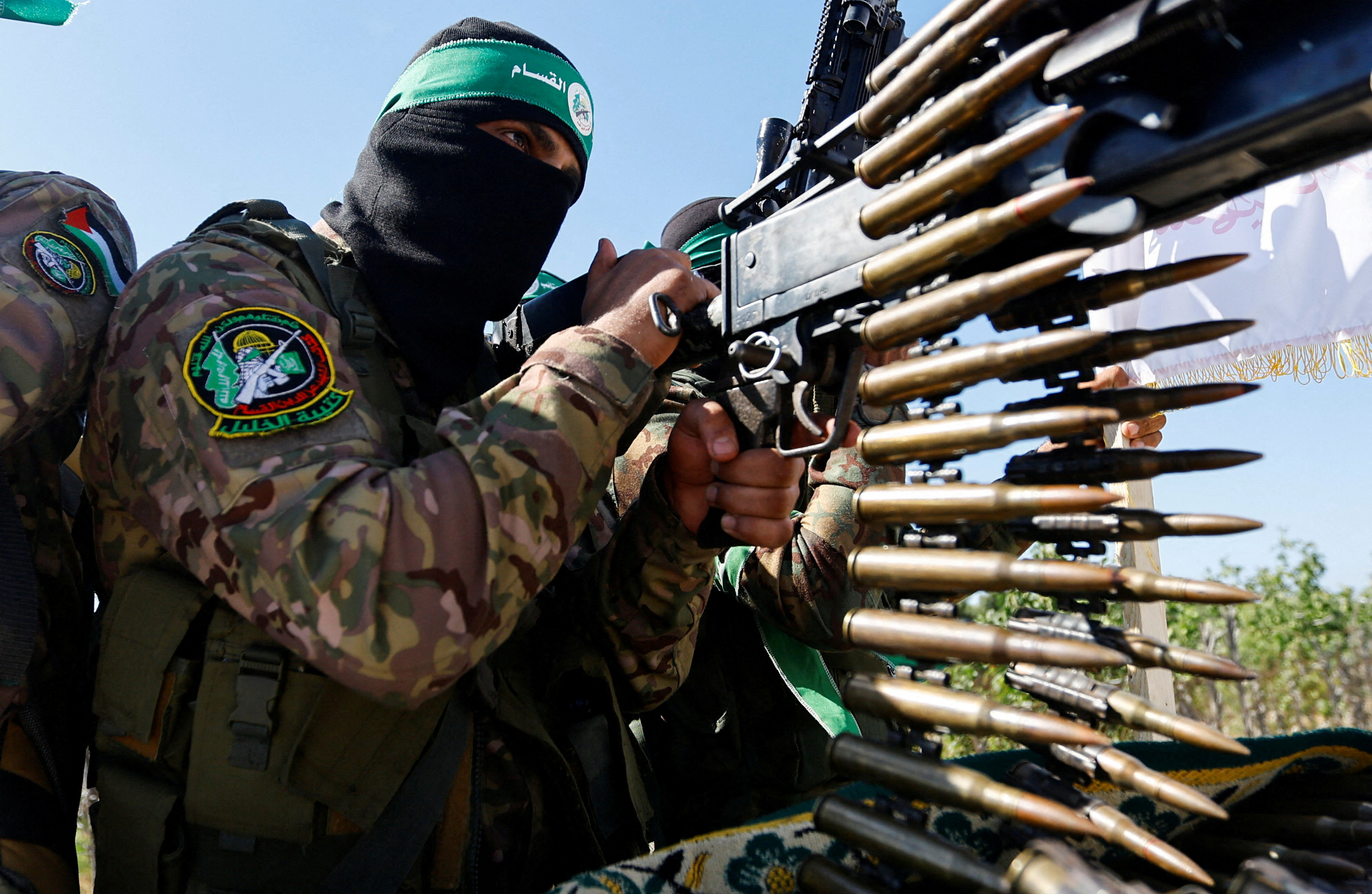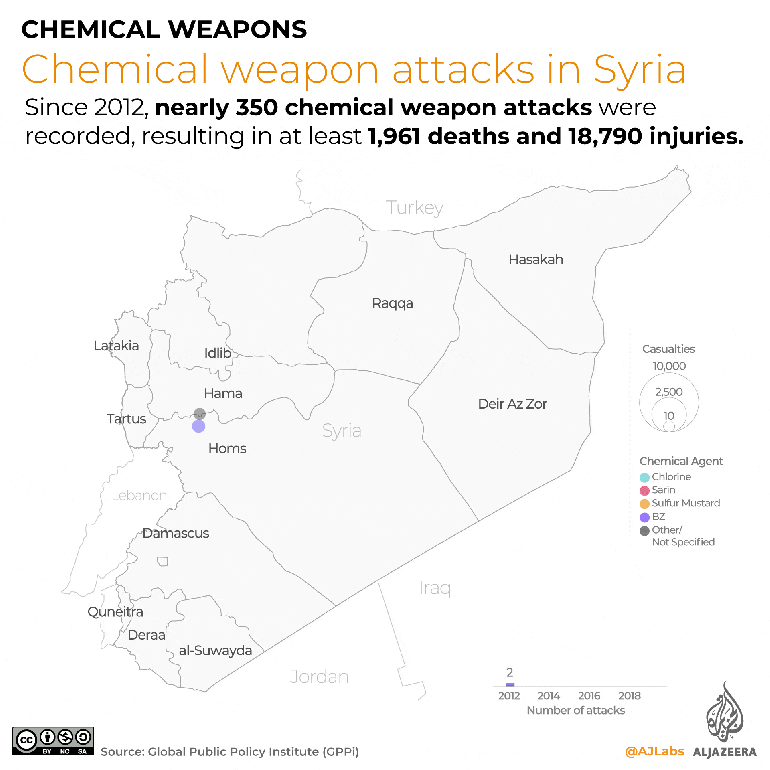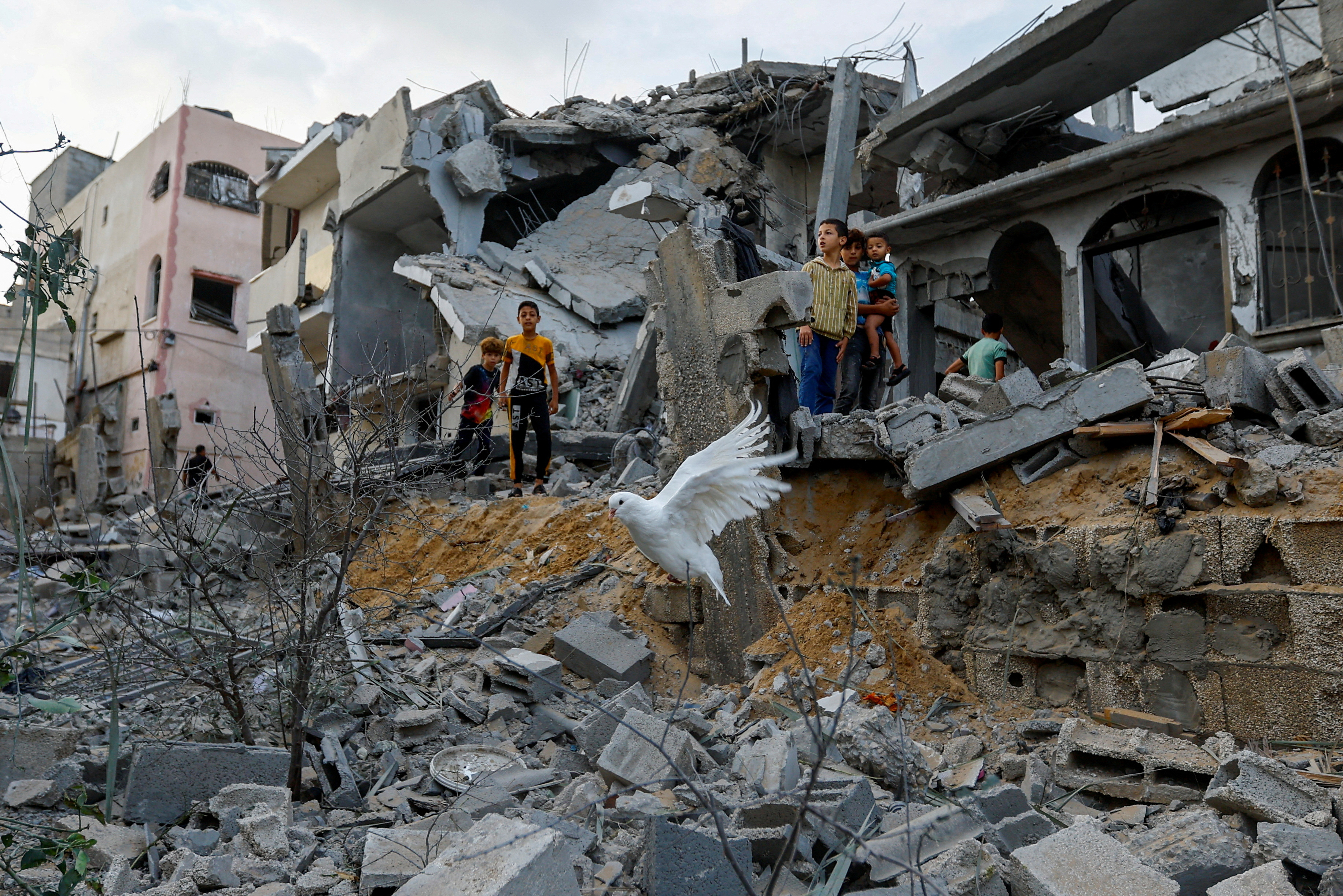The plan was to seal off Gaza's tunnels at both ends—and then promptly flood them with nerve gas.
At least, that's what an anonymous source told the questionable news outlet Middle East Eye in mid-October, a little more than two weeks after deadly terrorist attacks caused the single largest loss of life since the Holocaust of World War II.
According to Middle East Eye's source, Israel's military wouldn't attack Gaza head-on. Instead, they'd target Hamas' massive network of underground tunnels directly. Under the supervision of the U.S. Delta Force, they'd pump nerve gas and chemical warfare agents into the tunnels, killing anyone and everyone down there almost instantly.
"The plan hinges on the element of surprise to decisively win the battle," the source explained, "using internationally forbidden gasses, particularly nerve gas and chemical weapons. Large quantities of nerve gas would be pumped into the tunnels."

Hamas fighter in Gaza tunnel. (Image courtesy of ABC News)
Of course, this supposed nerve agent attack never actually happened.
As we now know, Israel opted for a crushing conventional military attack. Their invasion of Gaza has resulted in the loss of nearly 16,000 Palestinian lives since October 7, though a temporary ceasefire halted the hostilities for a short time.
But that didn't keep the media from stoking the flames of panic.
The story of Israel's "secret plans" for a nerve gas attack even made it as far as U.S. outlets like Newsweek.
And in fairness, the panic is understandable.
After all, the use of nerve gas in a conflict like this, in a densely-populated area like Gaza, is a real-world nightmare. With nerve agents like VX gas, as little as one drop can be fatal in a matter of minutes. Lethal doses are on the order of milligrams.
In other words—if any meaningful amount of nerve gas is circulated in Gaza, the death toll would be massive.
The attack would go down in history as one of the most tragic war crimes of all time, with the international community responding en masse.
Table of Contents
-
01
Israel's Nerve Gas History
-
02
The "Unknown" Stockpile
-
03
Hamas and WMDs
-
03
Escalating Conflict in the Middle East
-
03
Next-Gen PPE for Nerve Agent Protection
-
03
Final Thoughts
-
03
Frequently Asked Questions About Nerve Gas in the Conflict Between Israel and Palestine
Israel's Nerve Gas History
Israel's foreign policy, especially when it comes to the military, can be… complicated, to say the least.
For example, it's widely accepted as the truth that Israel possesses a small but effective nuclear arsenal. Somewhere on the order of as many as 300 nuclear weapons of varying sizes, with plenty of tactical potential in the event of another Six-Day War.
But Israel completely denies the existence of any nuclear arsenal.
Why?
Most countries that have nuclear weapons openly brag about it as a deterrent against attack. So why would Israel deny having any at all?
Because Israel's situation is complicated. If Israel touted its own nuclear arsenal, it could potentially kick off an arms race in the Middle East. That's not a good idea for anyone. Likewise, if Israel suddenly touted its own substantial nuclear arsenal, Iran might decide it needs their own for "self-defense."
Nuclear weapons, especially the tactical kind, are something Israel would rather "have and not need" instead of needing and not having. But their unique circumstances make it better if their neighbors don't know.

Israel’s Nuclear Development. (Image courtesy of Center for Arms Control and Non-Proliferation)
A similar policy likely applies to Israel's other weapons of mass destruction.
The proliferation of nerve gas and other chemical weapons has been a hotly-contested issue for the last century—frequently subject to political, bureaucratic and even practical concerns from all over the world.
Israel, notably, has committed to the Chemical Weapons Convention (CWC). The CWC is an international treaty designed to prevent the development and use of chemical weapons across the world—and Israel joined in 1993.
Under the rules of the CWC, member states are subject to strict verification as administered by a group called the Organization for the Prohibition of Chemical Weapons (OPCW). This includes routine inspections and reporting requirements—to which Israel is subject.
Nominally, these groups keep a country like Israel from procuring and developing nerve gas.
In reality, however, that's not the case…
The "Unknown" Stockpile
According to a CIA document that was publicized by Foreign Policy magazine, Israel has been maintaining an inventory of nerve gas and other chemical agents at least as far back as the 1980s.
Another 1983 document from U.S. intelligence sources claims Israel possesses a "probable" nerve gas production and storage facility known as the Dimona Sensitive Storage Area in the Negev Desert. That same report surmised that a state capable of maintaining these known facilities could likely also produce more chemical weapons.
This document could be seen to confirm Israel's possession of what are called "non-persistent" nerve gas weapons, which include threats like sarin gas (GB) that dissipate in the atmosphere. By that same token, it could also be seen to confirm their possession of mustard agents and lachrymatory/riot control gas.

Different Types of Nerve Agents. (Image courtesy of MDPI)
According to historian Avner Cohen's book "Israel and the Bomb," former Israeli Prime Minister David Ben Gurion ordered these stockpiles to be developed in secret following the 1956 war between Israel and Egypt.
And at the time, it made sense.
That’s because Israel's Six-Day War in 1967 further cemented the country's defensive mindset, one where a strong military would be instrumental to national security.
Once a practical, defensive concern, Israel's national military and private military organizations have since grown into a massive industry—and a powerful apparatus of the state.
This is arguably another reason for Israel's secrecy regarding its weapons of mass destruction (WMDs).
After all, if Israel revealed it had hundreds of nuclear warheads and a massive arsenal of nerve gas/CBRN weapons, then global perceptions might shift. Americans who once thought they were "backing the underdog" with Israel might suddenly ask why the country needed so many deadly weapons.
Bear in mind that Israel's military has almost always been a significant point of contention in politics, and now more than ever (especially for the country's conservatives).
Israeli Prime Minister Benjamin Netanyahu recently returned to office after establishing a new coalition among the country's far-right leaders. His government's inability to intercept or respond to the October 7 attacks is now being seen as an intelligence failure, causing his administration to be under closer scrutiny than ever.
On the one hand, this level of international scrutiny means it's extremely unlikely that Netanyahu would deploy nerve gas. It also means he has a vested interest in perpetuating the conflict for as long as possible, which could be part of the reason for his massive conventional response to the Hamas terrorist attacks.
But what about Hamas' potential to unleash nerve gas on Israeli civilians?
Hamas and WMDs
Hamas, short for Harakat al-Muqawama al-Islamiyya (Islamic Resistance Movement), was founded in 1987 during the First Intifada.
The hardline Palestinian nationalist group organized around the singular goal of independence and resisting occupation. Hamas has since grown in terms of support and funding while lashing out against Israeli occupiers in the form of protests, armed resistance, suicide bombings, and unexpected rocket attacks.
Though Hamas has repeatedly been accused of using chemical weapons, each of these occasions has lacked conclusive evidence.
In 2016, for example, the Israeli Defense Forces (IDF) accused Hamas militants of firing toxic substances via mortar shells towards IDF soldiers. These claims lacked verifiable evidence, leaving the international community in doubt.

Hamas Fighters ruthless in fighting against Israel. (Image courtesy of Reuters)
Again, in 2018, Israeli military officials claimed they'd discovered tunnels intended for the storage and use of chemical weapons. They even claimed the tunnels had ventilation systems to protect workers against exposure to the toxic agents—but international authorities remained doubtful.
Then, in 2021, Hamas was accused of deploying incendiary balloons, some of which were equipped with explosives and chemical weapons, which then caused fires throughout Southern Israel. Once again, the claims of WMD usage were doubted.
Even as recently as 2021, Hamas is alleged to have launched incendiary balloons loaded with toxic substances against Israeli civilians—but the international community demands more information.
Historically, each of these claims was tempered by the fact that they came from Israeli government and military officials—and thus embedded in the broader context of a centuries-old regional conflict. But given the recent, truly heartless attacks of October 7, 2023, it's essential to realize that Hamas will go to fanatical extents to damage Israeli life and statehood.
Of course, Hamas publicly denies the use of chemical weapons.
They argue that Israel's claims are merely an effort to delegitimize their cause (the terrorism of which is now beyond question).
But it wouldn't be the first time nerve gas and other CBRN threats were used in the Middle East…
Escalating Conflict in the Middle East
Unfortunately, the Middle East has a long history of chemical weapons usage in conflict—most notably during the Iran-Iraq War in the 1980s.
At that time, toxic threats were widely deployed and subsequently condemned by the international community. Iraqi forces used mustard gas against Iranian soldiers, leading to more than 50,000 casualties. One battle in the city of Halabja in Northern Iraq saw sarin gas and mustard deployed, killing an estimated 10,000 Iranians in a single attack.
Today's Israeli-Palestinian conflict, it must be stressed, is comparable regarding animosity and complicated regional dynamics.
And it wouldn't be the first Middle Eastern rivalry to erupt into vicious attacks with weapons of mass destruction.
Since 2012, almost 350 chemical weapons attacks have been recorded throughout the Middle East. These attacks resulted in roughly 2,000 deaths and nearly 19,000 injuries:

(Image courtesy of Al Jazeera)
Of course, the CWC has worked to reduce the occurrence of these types of attacks over time. But they're still a reality for the more than 400 million people currently living in the Middle East.
Fortunately, civilians now have access to practical protection from common nerve gas threats…
Next-Gen PPE for Nerve Agent Protection
The first step to surviving a potential nerve gas attack is to know precisely what kind of threat you're up against.
Remember: even a single drop of some nerve agents can be fatal. So it's crucial to know whether any are in the environment before you make your way to safety.
As such, you'll need a nerve gas detection tool like DETEHIT CWD-3 Detection Strips.

DETEHIT strips use immobilized cholinesterase to mimic the functioning of your body's nervous system. As soon as they're exposed to air, they'll start reacting. If they're exposed to a potentially fatal dose of nerve gas, they'll change color (which is a sign that you shouldn't take off your gas mask yet).
DETEHIT strips are extremely easy to use and perfect for identifying the presence and concentration of airborne threats (they react faster when nerve gas threats are in higher concentration).
You can also detect waterborne/particulate threats with our CBRN protection paper.

Expose the paper to a drop of water. If that water is contaminated with nerve agents, then the paper will change different colors depending on whether the nerve gas is a G agent (tabun, soman, sarin), a V agent (VX gas), or an H agent (mustard gas and other blister agents).
Finally, you'll need a full-face gas mask if nerve gas exposure is even remotely possible. For that, we recommend the CM-6M, our most popular and flexible mask, perfect for 95% of gas mask users.

To pair with that CM-6M, we'd also recommend an NBC-77 SOF gas mask filter.

The NBC-77 SOF gas mask filter can protect you from every threat on the CBRN spectrum. And with its twenty-year shelf life, it lasts as long as the average gas mask—giving you more long-lasting protection than any other gas mask filter on the market.
Of course, you'll also need full-body coverage for practical nerve gas protection. That includes our full-body MOPP suit, NC-11 CBRN protection gloves, and Combat CBRN overboots. But the three pieces of gear above are a great starting point for practical protection from chemical warfare threats.
Final Thoughts
The attacks of October 7, 2023 were an atrocity by any description—the kind of horror no human should ever have to face.
In response, Israel has unleashed an overwhelming show of force, complete with death and destruction, that's now more than ten times the size of those initial attacks. Even now, with a temporary ceasefire in place, Israel's ongoing counterattack looms large over the 2 million who call Gaza home.
Yet despite the rampant and continuous military escalation in the area, the use of nerve gas by either side seems extremely unlikely.

The aftermath of Israel’s devastating attacks on Gaza… (Image courtesy of Reuters)
For Israel, a nerve gas attack would jeopardize the country's entire narrative of being an outgunned minority in the Arab world. If Israel used nerve gas against Hamas (as that one early source claimed they inevitably would), the global response could be disastrous—and the Israeli government knows that.
So, for Netanyahu's sake, and for the sake of the $3.3 billion Israel receives in aid from the U.S., nerve gas is a terrible idea.
Meanwhile, Hamas has cemented its status as one of the world's most ruthless militant groups. And none of their foreign partners will likely give them nerve gas anytime soon.
The likelihood of having those weapons traced back to their source country, and the resulting international rage against said country means that no one is likely to send any of their own nerve gas or chemical arsenal into Palestine anytime soon.
Instead, the awful conclusion here is… no conclusion at all.
Both sides are too entrenched and invested in a conflict that has lasted for generations–one that will likely continue for generations more, whether or not nerve gas is ever involved.

